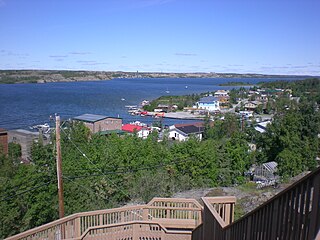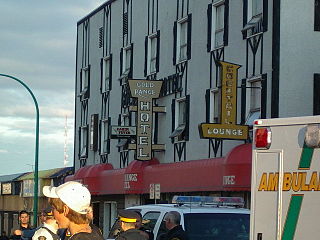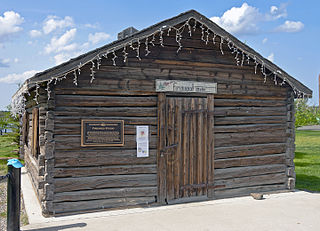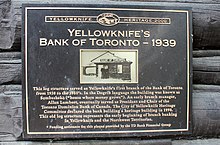
Yellowknife is the capital, largest community, and only city in the Northwest Territories, Canada. It is on the northern shore of Great Slave Lake, about 400 km (250 mi) south of the Arctic Circle, on the west side of Yellowknife Bay near the outlet of the Yellowknife River.
The Ptarmigan and Tom Mine were gold producers located in the Northwest Territories, Canada at Yellowknife. The property was staked by prospectors in 1936 and acquired by Cominco in 1938. The mine first produced between 1941 and 1942 but closed due to wartime restrictions. The old property was demolished in 1969–1970. A new company, Treminco Resources Limited, reopened the workings in 1985 and production from the Tom portal began in 1986 with material being trucked to Giant Mine. The old Ptarmigan mine shaft was dewatered and production began in 1987. A new mill was built at the property and was operational in July 1989. Low gold prices forced the company to close the mines in 1997. Total gold production has been approximately 120,000 troy ounces.
The Burwash Mine was a small gold property discovered in the fall of 1934 by Johnny Baker and Hugh Muir at Yellowknife Bay, Northwest Territories. The town of Yellowknife did not exist yet at that point, but the discovery of gold at Burwash was the catalyst that brought more gold prospectors into the region in 1935 and 1936. A short shaft was sunk in 1935–1936 at Burwash, and in the summer of 1935 a 16-ton bulk sample of ore was shipped to Trail, British Columbia for processing, yielding 200 troy ounces (6.2 kg) of gold. The mine did not become a substantial producer and it is believed the gold vein was mined out.

Abraham Lincoln Birthplace National Historical Park is a designated U.S. historic park preserving two separate farm sites in LaRue County, Kentucky, where Abraham Lincoln was born and lived early in his childhood. He was born at the Sinking Spring site south of Hodgenville and remained there until the family moved to the Knob Creek Farm northeast of Hodgenville when he was two years old, living there until he was seven years of age. The park's visitor center is located at the Sinking Spring site.

The Wildcat Cafe is a vintage log cabin structure in Yellowknife, Northwest Territories, Canada and represents the mining camp style of early Yellowknife. The structure, which houses a summer restaurant, is located in what was then the central business district of the city. It is a City of Yellowknife Heritage Building, designated in 1992. First opened in 1937 by owners Willie Wylie and Smokey Stout, it is the oldest restaurant in Yellowknife. Subsequent owners were Carl and Dorothy Jensen (1939–1942) and Mah Gow (1942–1951), Yellowknife's first recorded Chinese resident. The cafe closed in 1951 with the illness of Mr. Gow. The building was saved from demolition in the late 1950s when a small group of Yellowknifers fought to have it protected as a heritage site. By 1970 no work had been done to restore the abandoned cabin and it was in poor shape when a new generation of concerned citizens lobbied for its protection. It was soon renovated and reopened as a functional restaurant in 1979. The Old Stope Association, a non-profit heritage society, was responsible for its operation in the 1970s–1980s, and today it is managed by the Wildcat Cafe Advisory Committee. In 1992, the cabin was declared a heritage site as an important old building in Yellowknife and the city took ownership. It is one of Yellowknife's most popular tourist attractions.

The Gold Range is a Canadian hotel and bar located in Yellowknife, Northwest Territories.

The Guild Inn, or simply The Guild was a historic hotel in the Guildwood neighbourhood of Scarborough, Toronto, Ontario and was once an artists colony. The surrounding Guild Park and Gardens is notable for a sculpture garden consisting of the rescued facades and ruins of various demolished downtown Toronto buildings such as bank buildings, the old Toronto Star building and the Granite Club. The park is situated on the Scarborough Bluffs with views of Lake Ontario. Guild Park remained open and the refurbishment of the Guild Inn into a facility for social events was completed in May 2017.

Middleton Tract is a rural community in the coastal Redwoods of San Mateo County, California. Unattributed press reports say the name Middleton Tract may have been applied to this area as early as 1925. In the present day, the name is official at the county government level. It appears on County Assessor's maps including County of San Mateo, Master Index Map, Revision 2, June, 1985,, page 40–41.
Old Fort Providence, located near the mouth of Yellowknife Bay, Northwest Territories, Canada, was one of the first fur trading outposts on Great Slave Lake. Peter Pond of the North West Company first proposed trading with the Dene around Great Slave Lake in 1786. In 1789, Alexander Mackenzie initiated a period of trade with the Yellowknives and Tłı̨chǫ Dene and instructed his assistant, Laurent Leroux, to start a trading post in this area. The post was not a major centre for fur trading and was used primarily as a supply centre for other, more important trading posts or expeditions. It served, for example, as a base of supply for Sir John Franklin's Coppermine expedition towards the Arctic Ocean in 1820. It was located within a productive fishery used for generations by the Dene around Yellowknife Bay and helped supply meat and fish for traders at Great Slave Lake. The Hudson's Bay Company took over the post in 1821 after the demise of the North West Company, but the settlement was in decline and it closed in 1823. The buildings have long since decayed but the ruins were excavated in 1969-1971.

The Yellowknife Education District No. 1map 1 is the public school board in Yellowknife, Northwest Territories. The district, then called Yellowknife School District No. 1, was created 1 October 1939 by Charles Camsell who was Commissioner of the Northwest Territories.

John Cox Cottage, at 469 Broadview Avenue, Toronto, Ontario, Canada, is the oldest known house in the city still used as a residence, and it still resides on its original site. The property, immediately to the east of what was John Scadding's original lot, was deeded to John Cox by Governor Simcoe in 1796.
This timeline of Yellowknife history summarises key events in the history of Yellowknife, a city in the Northwest Territories, Canada.

Sutherland's Drug Store is a small family-owned drug store in Yellowknife, Northwest Territories, Canada. The company was established in Fort McMurray, Alberta by Angus Sutherland in 1918 and expanded into the Yellowknife gold fields during the rush in 1938. Its first store was located in Old Town Yellowknife and was managed by Walter Hill and Keith Miller. The store closed during the war but reopened and expanded following the post-war gold boom. In 1948, the Old Town store was physically moved to the new downtown development and a second store was built in Old Town. Two stores were run by the chain into the 1950s. In 1951, Doug and Wilma Finlayson and A.L. Blackberg bought the Sutherland chain following the death of Angus Sutherland. In 1954, the Old Town store closed; in 1956, the current downtown store was built and the original store brought up from Old Town years previous was rented to commercial tenants. Sutherland's Drug Store continues to operate today in its expanded storefront and successfully competes with larger department stores in Yellowknife.

Centre Square Mall is an enclosed shopping mall in Yellowknife, Northwest Territories, Canada. The mall is noteworthy for being the largest shopping centre in the territory and the tallest building in Northern Canada. The first phase of the mall was opened in August 1990; the expansion of the mall beneath the Yellowknife Inn was opened in January 1995.

The Hudson's Bay Company began a trading post in Yellowknife, Northwest Territories, Canada in 1938 at the height of the first gold rush in the region. Fire destroyed the original building in January 1945, and the HBC rebuilt and reopened this expanded trading post store and warehouse in November 1945. It served the Old Town waterfront of Yellowknife for several years. The post was primarily designed for prospector's bush orders during the gold boom years. With the opening of a modern downtown department store in 1947, the Old Town post catered almost exclusively to bush orders, fur trappers, commercial fishers, and prospector supplies. The store closed in 1960 when all HBC operations were centralized to the downtown location. Thereafter, the building was used only as a warehouse for HBC retail operations. The Bay retail stores were rebranded as Northern Stores Inc in 1987 and the warehouse was sold to Les Rocher who has owned it ever since.

Canadian Pacific Airlines built this modern float base on the waterfront of Yellowknife, Northwest Territories, Canada in 1946 to serve as an office, staff housing, and mooring for its fleet of bush planes. Yellowknife was a very active aviation centre during the late 1940s as a result of renewed gold exploration after World War II. The aviation industry however was very tumultuous and many bankruptcies and mergers occurred throughout history, and many airline companies came to use this float base in Yellowknife, including: Canadian Pacific Airlines (1946–1949), Yellowknife Airways (1949–1951), Associated Airways Limited (1951–1956), Pacific Western Airlines (1956–1966), Northward Airlines (1966–1978), and Air Dogrib (1978–1980s).

The Fireweed Studio is a log cabin in Yellowknife, Northwest Territories, Canada, located in Somba K'e Park near City Hall. It was built in the late 1930s to house explosives at what later became Giant Mine, and later moved to its present location. In 1996 it was listed on the Canadian Register of Historic Places; two years later it was designated a city Heritage Building for its status as a well-preserved remnant of the city's early years.

The first building used as a school in Yellowknife, Northwest Territories, Canada, is currently located on Franklin (50th) Avenue at the south end of New Town, the city's downtown section. It is a small log cabin dating to the mid-1930s. It was designated a City of Yellowknife Heritage Site in 1998, and listed on the Canadian Register of Historic Places in 2004.
Ranney Hill is a rock outcrop approximately 10 kilometers north of Yellowknife, the capital city of the Northwest Territories of Canada. At 682 ft / 208 m. high, it is one of three visible outcrops that can be seen north of the city. It is an anomaly rising from the relatively flat Canadian Shield.

Guild Park and Gardens is a public park in the Scarborough district of Toronto, Ontario, Canada. The park was formerly the site of an artist colony and is notable for its collection of relics saved from the demolition of buildings primarily in downtown Toronto arranged akin to ancient ruins. Located on the Scarborough Bluffs, Guild Park and Gardens has an outdoor Greek stage and a 19th-century log cabin among the oldest in Toronto. The principal building in the park is the Guild Inn, a former inn and estate mansion.
















